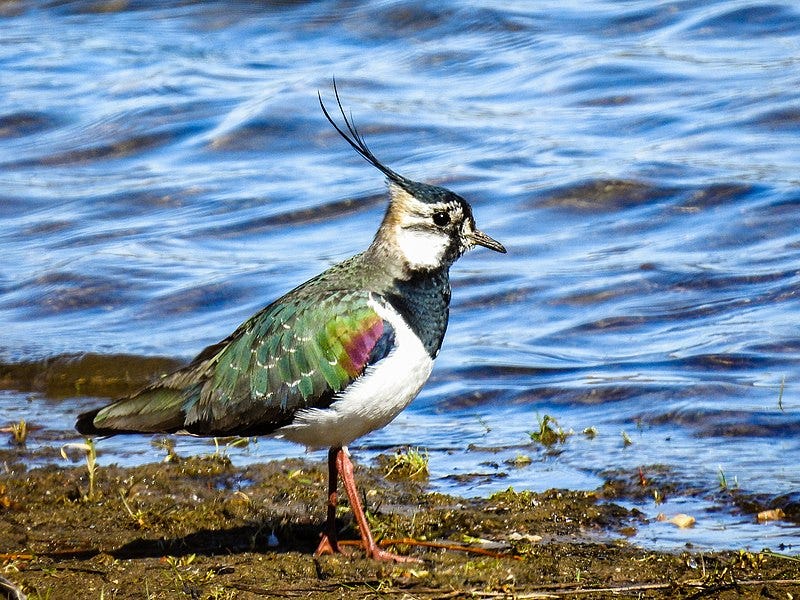I want to share a poem with you, but it requires a little bit of exposition.
On November 15th, a KLM airbus departing from Amsterdam Schiphol airport collided with a flock of birds, which resulted in damage to both engines and an emergency landing back at Schiphol just 27 minutes after take-off. No humans were harmed in the process. Of the birds there is no further mention, except from the pilot commenting under a Youtube video of the landing: “After T/O, at a low altitude ( 400-500 ft) we flew through a very large flock of birds. Possibly kievits.”
The kievit, or lapwing in English, is one of the Netherlands’ most characteristic meadow birds, nesting almost exclusively in grasslands and fields. Declining populations have landed it a spot on the Netherlands’ Orange List, as the bird’s way of life conflicts with human demands for intensified agriculture,1 but that is a story for another time. Back to the skies.
Bird strikes are a fairly common occurrence in air travel, the most famous one causing an emergency ditching in the Hudson River in New York after the aircraft hit a flock of geese departing from New York-La Guardia Airport in January 2009. The scholar Charlotte Wrigley, in her paper It’s a bird! It’s a plane! An aerial biopolitics for a multispecies sky, digs into the (physical, legal, political, philosophical) technicalities of bird-plane collisions to supply the theory for this incident. Reading the paper for a class last year, I was struck by both the information it contains and the language used to convey it. For example:

And so, I spent a couple of hyper-focused hours highlighting and rearranging phrases until I was left with something like a skeleton-summary in poetic form. This poem, too, examines “the frictions and entanglements of both human and non-human agency that are generated by differential air spaces”, just in a different register.
All words by Charlotte Wrigley, all shuffling by me. Here goes without further ado:
It’s a bird! It’s a plane!
Bird strikes are increasing globally. We share the sky with other creatures and sometimes these creatures cause us harm.
A bird strike:
an object hitting the aircraft.
Bird vision differs radically to human vision.Control and categorise air.
Fire dead birds
through set velocities.
The largest jet engines must be able to ingest four medium-bodied birds
or one large-bodied bird.Remove and control bird agency.
The gelatine bird
standardised for testing
in uniform shapes and sizesControl and categorise air
Produce the singularity necessary for legal airworthiness.
Improve aircraft survivability.Remove and control bird agency.
A 13-km radius around an airfield.
A bird scarer is on site at all times.
Species are assigned a threat category of green, amber or red
and are defined as controllable
or uncontrollable.
When a bird becomes too much of a problem, the team resort
to more permanent means of dispersal:
Jeremy keeps a 12-bore shotgun
12-bore pistol
and a gas-powered air gun on hand.
"We take it personally if we get a bird strike."Bird vision differs radically to human vision.
Most birds do not regularly fly above 1,500 feet.
Birds and humans meet at these altitudes
but the human body is altered
and protected.A bird strike:
an object hitting the aircraft.
"I’ll never forget those awful, unnatural noises and vibrations.
They sounded and felt BAD!
And then I smelled a distinct odour:
burning birds."Control and categorise air.
The sky is an incorporeal arena
of corporeal resistance
bird bodies resisting jet engines
human bodies resisting hypoxia
plane bodies resisting gravitational pulls.Bird vision differs radically to human vision.
Although no humans died
as a result of Flight 1549’s ditch into the Hudson,
geese did. Foreign material
consistent with bird feathers and tissue
was found wedged between the outer platform panels and the fan case.Remove and control bird agency.
Breathable air for birds
is often removed if they transgress
safety boundaries.
In the summer of 2009, geese were rounded up
from 17 different sites across the city
and gassed
with lethal doses of carbon dioxide.Bird vision differs radically to human vision.
It no longer becomes a case of murdering defenceless birds
(bad)
but instead a removal of hazards in the name of safety
(good)Control and categorise air.
Once beyond the container of goose corpses
this narrative begins to break down.
Flying birds begin to unsettle
safety assumptions.Remove and control bird agency.
Within a dynamic and uncontrollable sky
an assumption of spatial
control is a fallacy
borne from hubris.Bird vision differs radically to human vision.
They’re a much better pilot than you.


